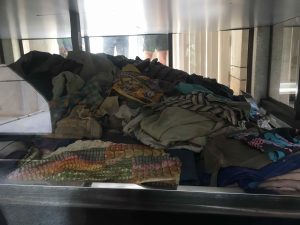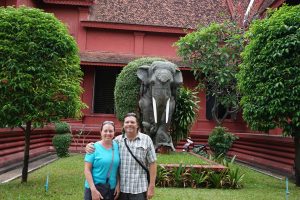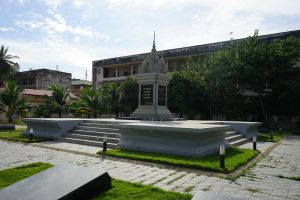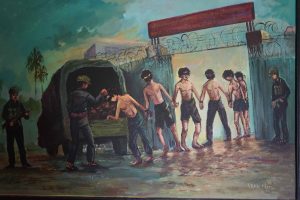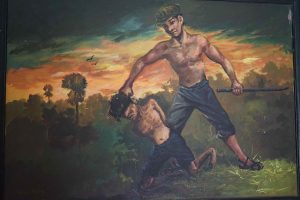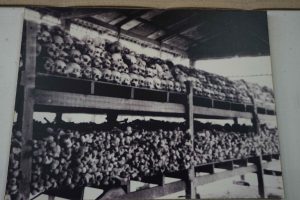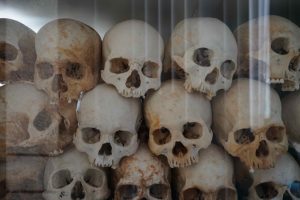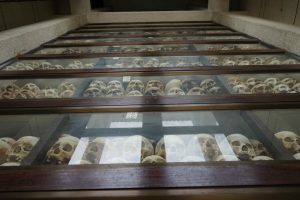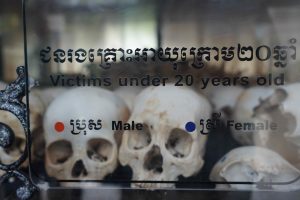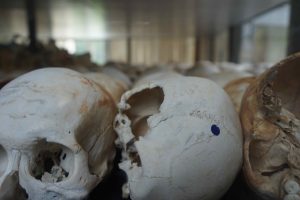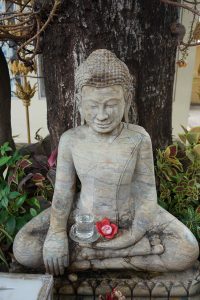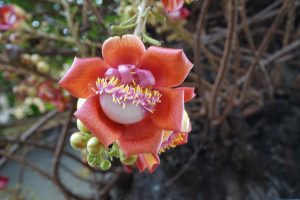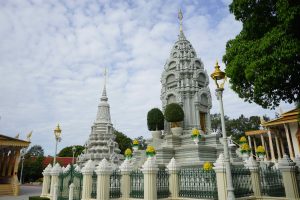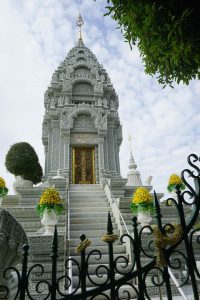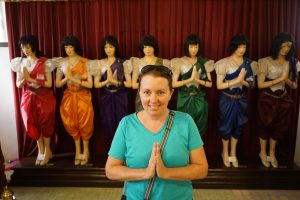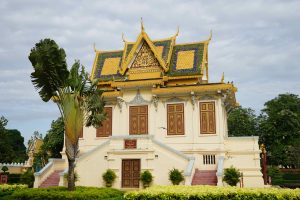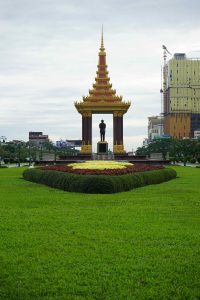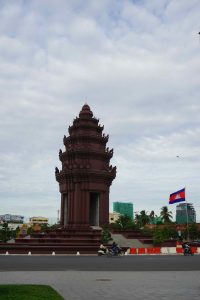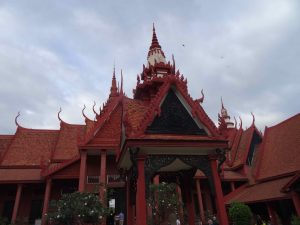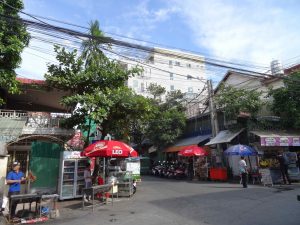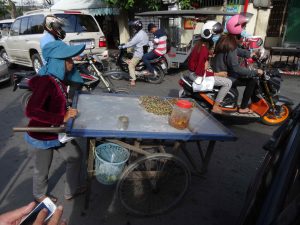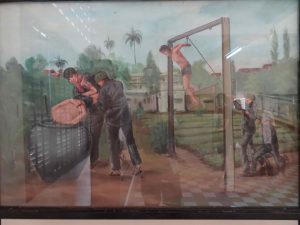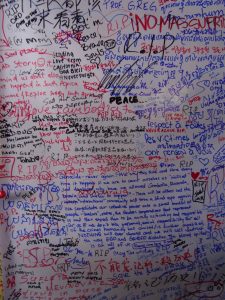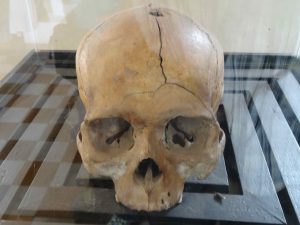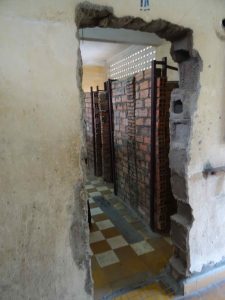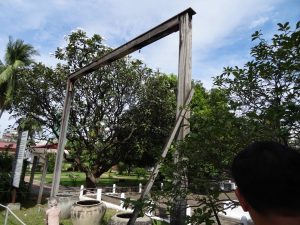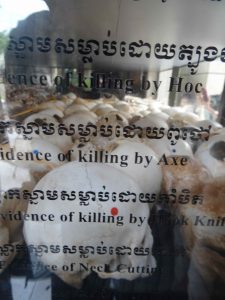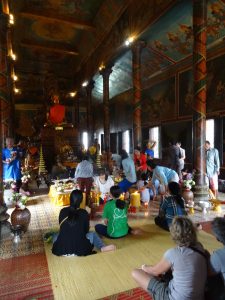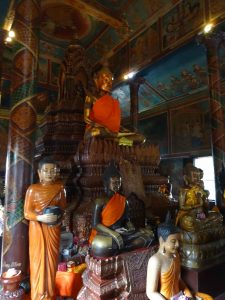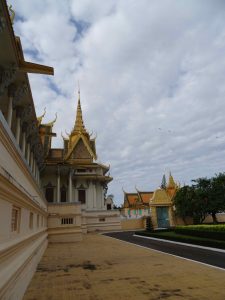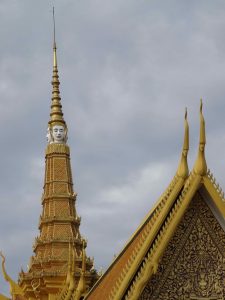It’s a short flight from Ho Chi Minh City to Pnom Penh, 40 minutes on Vietnam Airlines. All nice planes, on schedule and with good service!
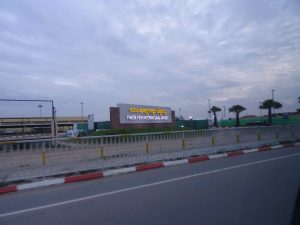 We pass through immigration and customs at the Phnom Penh airport with literally, a wave! A new country for us! We are met by our driver at the airport upon arrival and head to our hotel.
We pass through immigration and customs at the Phnom Penh airport with literally, a wave! A new country for us! We are met by our driver at the airport upon arrival and head to our hotel.
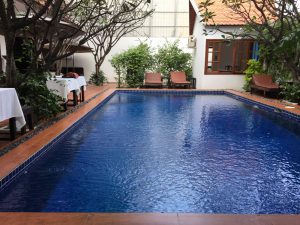
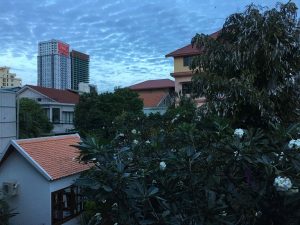 Our hotel for two nights is Hilary’s Boutique Hotel in the city center. It is about a one hour drive, mostly because of traffic. There are more cars here than in Vietnam. Maybe as many cars as scooters! The driving seems a little more subdued than Vietnam, just a little. It still flows almost like water, following the path of least resistance with less regard for driving rules.
Our hotel for two nights is Hilary’s Boutique Hotel in the city center. It is about a one hour drive, mostly because of traffic. There are more cars here than in Vietnam. Maybe as many cars as scooters! The driving seems a little more subdued than Vietnam, just a little. It still flows almost like water, following the path of least resistance with less regard for driving rules.
We are staying in an area called the BKK, an area that would be the equivalent of a yuppie area in the U.S., but at a different level.
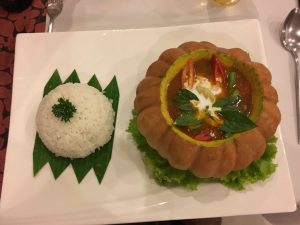
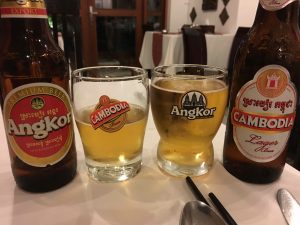 We dine at the small hotel on local Cambodian food, a vegetable curry, chicken curry and coconut, and sampling two of the countries beers, Angkor and Cambodia…both delicious!
We dine at the small hotel on local Cambodian food, a vegetable curry, chicken curry and coconut, and sampling two of the countries beers, Angkor and Cambodia…both delicious!
Our first full day in Cambodia is a FULL one.
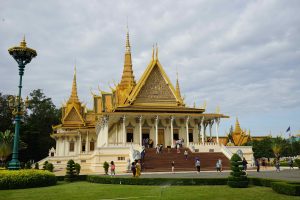 We begin with a stop at the Royal Palace Complex, the home to the Royal Family of Cambodia. There are beautiful structures and manicured tropical landscapes. The current King, 64, and his mother the Queen live there. He is not married, no children and “loves ballet”, lol. So our guide tells us there will be no descendants to this throne.
We begin with a stop at the Royal Palace Complex, the home to the Royal Family of Cambodia. There are beautiful structures and manicured tropical landscapes. The current King, 64, and his mother the Queen live there. He is not married, no children and “loves ballet”, lol. So our guide tells us there will be no descendants to this throne.
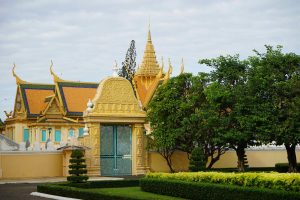
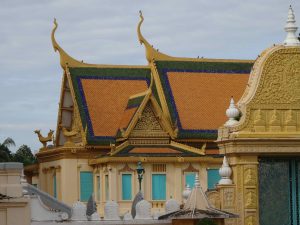 We are able to see their residence from the outside, but not able to get too close. They apparently rarely come outside. The flag is flying, indicating so. (I did however read the next day that in the afternoon the King and his mother took a train yesterday afternoon to Sihanoukville to promote a new train line.)
We are able to see their residence from the outside, but not able to get too close. They apparently rarely come outside. The flag is flying, indicating so. (I did however read the next day that in the afternoon the King and his mother took a train yesterday afternoon to Sihanoukville to promote a new train line.)
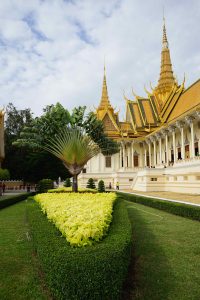
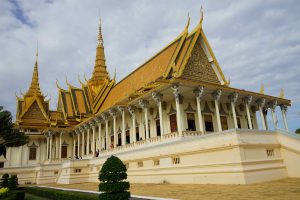 We are not allowed inside the Throne Hall. We are able to look inside, no pictures allowed. The hall is beautiful.
We are not allowed inside the Throne Hall. We are able to look inside, no pictures allowed. The hall is beautiful.
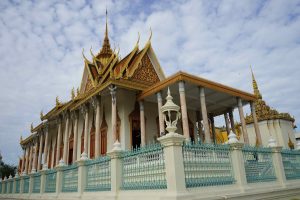 We also are not allowed to take pictures in the Silver Pagoda. The entire floor is made of over 5,000 silver tiles, each one weighing over 1 kg. Over the years the tile in this 19th century building has lost some of their luster, as the amount of silver in the floor is reduced from the foot traffic. The amount of gold and diamonds in this incredible building is amazing, as well.
We also are not allowed to take pictures in the Silver Pagoda. The entire floor is made of over 5,000 silver tiles, each one weighing over 1 kg. Over the years the tile in this 19th century building has lost some of their luster, as the amount of silver in the floor is reduced from the foot traffic. The amount of gold and diamonds in this incredible building is amazing, as well.
There are a couple Buddha images here. One is life-size, made of gold with 9,584 diamonds, the largest weighing 25 carats! The room also had a beautiful large jade Buddha made of baccarat crystal.
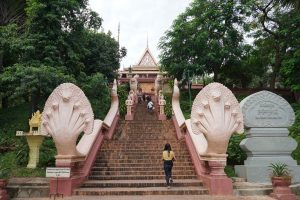
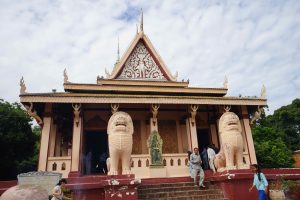 From here we go nearby to Wat Phnom Daun Penh, the source of the city’s modern name. Phnom Penh literally means “Phenh’s hill”. The temple is built on a small hill, about 90 feet in height. The legend is that Lady Penh found four bronze buddha statues and a stone Vishnu statue in a tree floating in the river after a flood. She constructed a shrine made of the Koki tree wood, the statues were found within. To protect the statues, the shrine was constructed on this artificial hill built by locals.
From here we go nearby to Wat Phnom Daun Penh, the source of the city’s modern name. Phnom Penh literally means “Phenh’s hill”. The temple is built on a small hill, about 90 feet in height. The legend is that Lady Penh found four bronze buddha statues and a stone Vishnu statue in a tree floating in the river after a flood. She constructed a shrine made of the Koki tree wood, the statues were found within. To protect the statues, the shrine was constructed on this artificial hill built by locals.
Before reading further, the following is text and pictures that tell and illustrate a bit about Cambodia’s gruesome past, with the horrible Khmer Rouge, including the “killing fields”. Important history, but not for the faint of heart.
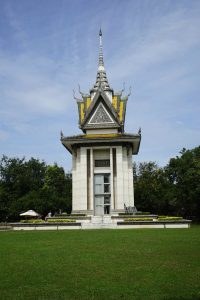
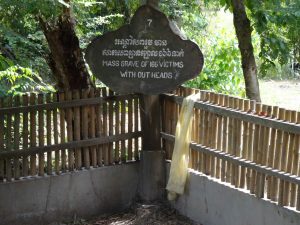
Later in the morning, we travel about 15 km to a devastatingly somber area, the Killing Fields of Choeung Ek. There are as many as 343 killing fields across Cambodia where the Khmer Rouge exterminated political prisoners under the leadership of Pol Pot between 1975 and 1979. Reportedly as many as 1.4 million people were murdered, perhaps double that when starvation is included. This is out of a 1975 population of roughly 8 million (our guide tells us up to two million killed by “tools” and another million starved to death).
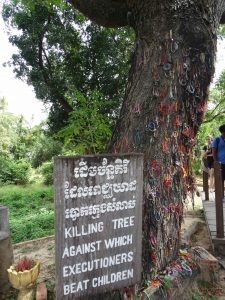
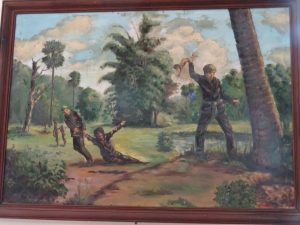 Pol Pot’s methods of murder were absolutely horrid. In order to preserve ammunition, methods used included poison, spades or sharpened bamboo sticks, even by sawing using sharp edges of palm fronds. In some cases, the children and infants were killed by having their heads bashed against the trunks of trees, referred to as “killing trees’. They would then be thrown into mass graves or pits alongside their parents. Up until a few years ago blood still remained on the trees at this site.
Pol Pot’s methods of murder were absolutely horrid. In order to preserve ammunition, methods used included poison, spades or sharpened bamboo sticks, even by sawing using sharp edges of palm fronds. In some cases, the children and infants were killed by having their heads bashed against the trunks of trees, referred to as “killing trees’. They would then be thrown into mass graves or pits alongside their parents. Up until a few years ago blood still remained on the trees at this site.
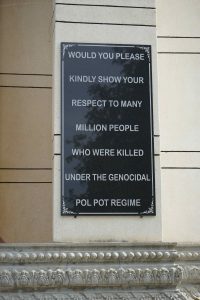 Pol Pot and the Khmer Rouge’s plan was to turn the country into a totally agrarian one. He had initially tricked the people of Cambodia into giving him support, promising to fight for the people of Cambodia. Ultimately he ordered people out of the cities and into the country side. He focused on killing anyone with an education, doctors, lawyers, teachers, etc. Phnom Penh was a ghost town for several years from 1975 to 1979.
Pol Pot and the Khmer Rouge’s plan was to turn the country into a totally agrarian one. He had initially tricked the people of Cambodia into giving him support, promising to fight for the people of Cambodia. Ultimately he ordered people out of the cities and into the country side. He focused on killing anyone with an education, doctors, lawyers, teachers, etc. Phnom Penh was a ghost town for several years from 1975 to 1979.
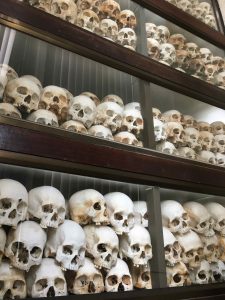
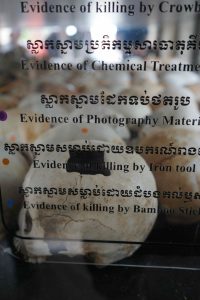 The remains of nearly 9,000 people were exhumed on this site from mass graves. Nearly that many skulls are enshrined in a towering acrylic glass case to remember. They are organized by age, sex and catalogued by the type of death. You can see the actual skulls and the trauma inflicted upon them to cause death.
The remains of nearly 9,000 people were exhumed on this site from mass graves. Nearly that many skulls are enshrined in a towering acrylic glass case to remember. They are organized by age, sex and catalogued by the type of death. You can see the actual skulls and the trauma inflicted upon them to cause death.

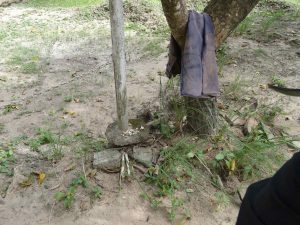 Not all of the graves were exhumed and many still remain untouched. As we walk through the area we can still see fragments of human bone and clothing scattered around the pits. Apparently when there are heavy rains in the area more remains are discovered. This is absolutely gut wrenching.
Not all of the graves were exhumed and many still remain untouched. As we walk through the area we can still see fragments of human bone and clothing scattered around the pits. Apparently when there are heavy rains in the area more remains are discovered. This is absolutely gut wrenching.
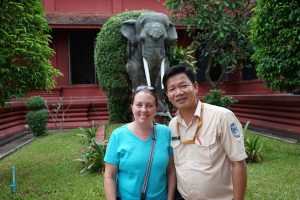 Our guide, for this tour, tells us of his family’s personal experience. I surmised he was alive then, so I asked him about his family. In 1975 he was five years old. He was taken from his mother and separated from his brothers and sisters. His father was a teacher, educated…his fathers throat was slit and bled to death. Our guide tells us he was taken to the jungle by the Khmer Rouge soldiers. He was given porridge to eat each day, 2 spoonfuls. At night while the soldiers would drink, he would sneak away in the jungle and eat bugs and worms.
Our guide, for this tour, tells us of his family’s personal experience. I surmised he was alive then, so I asked him about his family. In 1975 he was five years old. He was taken from his mother and separated from his brothers and sisters. His father was a teacher, educated…his fathers throat was slit and bled to death. Our guide tells us he was taken to the jungle by the Khmer Rouge soldiers. He was given porridge to eat each day, 2 spoonfuls. At night while the soldiers would drink, he would sneak away in the jungle and eat bugs and worms.
A couple of years later, he was reunited with his mother. His own mother did not even recognize him initially, as his malnutrition had taken an impact on his body.
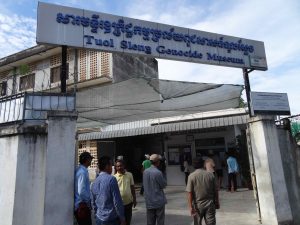
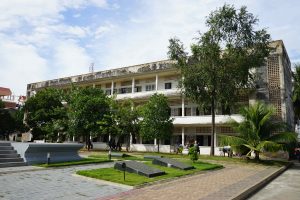 At this point, with good reason, we didn’t feel much like lunch. We drove back into Phnom Penh to the infamous high school that was converted into a prison, called S-21 (Security Prison 21), torture and interrogation center by the Khmer Rouge in 1975. It is now the Tuol Sleng Genocide Museum. The torture, interrogation methods, forced confession techniques and even medical experiments conducted without anesthesia were absolutely unimaginable and horrendous.
At this point, with good reason, we didn’t feel much like lunch. We drove back into Phnom Penh to the infamous high school that was converted into a prison, called S-21 (Security Prison 21), torture and interrogation center by the Khmer Rouge in 1975. It is now the Tuol Sleng Genocide Museum. The torture, interrogation methods, forced confession techniques and even medical experiments conducted without anesthesia were absolutely unimaginable and horrendous.
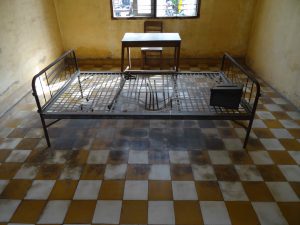
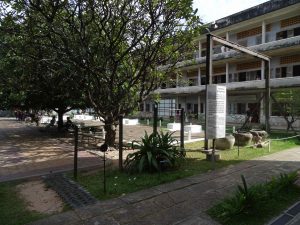 It is thought that up to 20,000 people passed through this prison and eventually were killed. There were only seven survivors of the 20,000, three still alive today. They were kept alive because of useful skills they had to the Khmer Rouge.
It is thought that up to 20,000 people passed through this prison and eventually were killed. There were only seven survivors of the 20,000, three still alive today. They were kept alive because of useful skills they had to the Khmer Rouge.
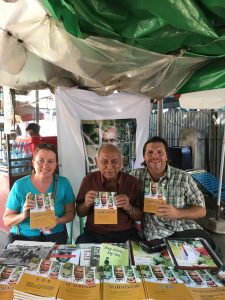 We were able to meet one of those survivors, Chum Mey, who was on the grounds the day we were there. He was not killed because he knew how to repair typewriters, which were needed for communication. He was also brutally tortured and many family members killed, including his wife and son. For more on his harrowing story, click here.
We were able to meet one of those survivors, Chum Mey, who was on the grounds the day we were there. He was not killed because he knew how to repair typewriters, which were needed for communication. He was also brutally tortured and many family members killed, including his wife and son. For more on his harrowing story, click here.
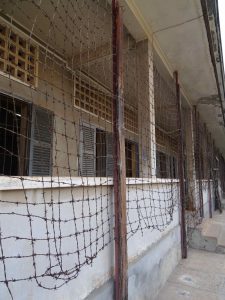 During our tour there, we are able to pass through the five buildings that were converted from classrooms into torture chambers and holding cells. Some of the rooms still had blood stained floors. Electrified barbed wire was used, as well as, shackles to restrain prisoners. As we passed through the buildings and grounds we saw the human remains, piles of clothes, rooms used for rape and torture methods including gallows for hanging.
During our tour there, we are able to pass through the five buildings that were converted from classrooms into torture chambers and holding cells. Some of the rooms still had blood stained floors. Electrified barbed wire was used, as well as, shackles to restrain prisoners. As we passed through the buildings and grounds we saw the human remains, piles of clothes, rooms used for rape and torture methods including gallows for hanging.
We return to our hotel after an emotionally exhausting day. It is horrifying to even imagine these events happening, but even more horrifying to think that these kinds of activities still occur in regimes in parts of the world today.
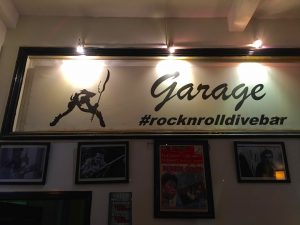
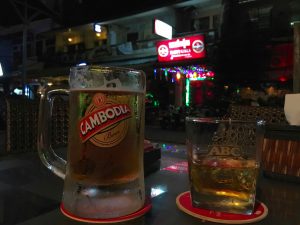 After a brief rest, we head to the riverfront in Phnom Penh for dinner. We sit outside at the Garage Bar and enjoy a couple of drinks and a great grilled burger and fries.
After a brief rest, we head to the riverfront in Phnom Penh for dinner. We sit outside at the Garage Bar and enjoy a couple of drinks and a great grilled burger and fries.
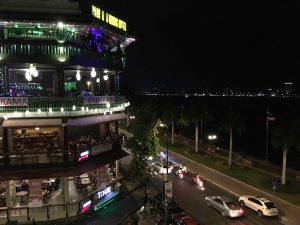 We ventured down the strip and waterfront to the Foreign Correspondents Club for a nightcap. This spot was opened up in the 1990s. It has nice views overlooking the river and the activity in the street below. [spacer height=”20px”
We ventured down the strip and waterfront to the Foreign Correspondents Club for a nightcap. This spot was opened up in the 1990s. It has nice views overlooking the river and the activity in the street below. [spacer height=”20px”
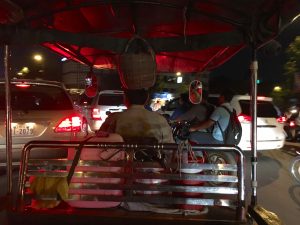 We head back to our hotel as our journey to explore northern Cambodia begins early in the morning!
We head back to our hotel as our journey to explore northern Cambodia begins early in the morning!
And a few more pics…
